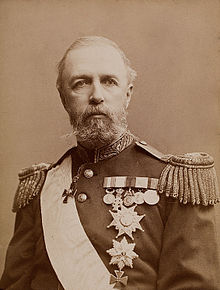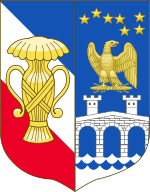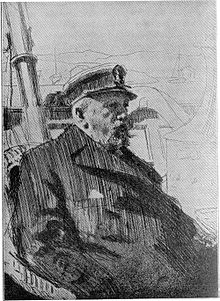- Oscar II of Sweden
-
Oscar II (21 January 1829 – 8 December 1907), baptised Oscar Fredrik[1] was King of Sweden from 1872 until his death and King of Norway from 1872 until 1905. The third son of King Oscar I of Sweden and Josephine of Leuchtenberg, he was a descendant of Gustav I of Sweden through his mother.
Contents
Early life
At his birth in Stockholm, Oscar Fredrik was created Duke of Östergötland. He entered the navy at the age of eleven, and was appointed junior lieutenant in July 1845. Later he studied at Uppsala University, where he distinguished himself in mathematics. On 13 December 1848, he was made an honorary member of the Royal Swedish Academy of Sciences.
On 6 June 1857 he married in Wiesbaden-Biebrich, Germany, Princess Sophia Wilhelmina, youngest daughter of Duke William of Nassau.
From 1859, when his father died, he was first in line to the Swedish throne after his oldest brother King Charles, who then had no male heirs (his son had died in infancy in 1854). His middle brother Gustaf had died in 1852.
King of Sweden and Norway
 King Oscar in full regalia – he was the last crowned Swedish king and was known to enjoy the pomp and ceremony.
King Oscar in full regalia – he was the last crowned Swedish king and was known to enjoy the pomp and ceremony.
He succeeded his brother Charles XV on 18 September 1872, and was crowned as king of Norway in the Nidaros Cathedral in Trondheim on 18 July 1873. At the accession he adopted as his motto Brödrafolkens väl / Broderfolkenes Vel ("The Welfare of the Brother Peoples"). While the King and the Royal Court resided mostly in Sweden, Oscar made the effort of learning to be fluent in Norwegian and from the very beginning he realized the essential difficulties in the maintenance of the union between the two countries. The political events which led up to the peaceful dissolution of the union between Norway and Sweden in 1905 could hardly have been attained but for the tact and patience of the king himself. He was dethroned on 7 June 1905 by the Norwegian Parliament and renounced the Norwegian throne on 26 October. He declined, indeed, to permit any prince of his house to become king of Norway, but better relations between the two countries were restored before his death, which occurred in Stockholm on 8 December 1907.
Politics
His acute intelligence and his aloofness from the dynastic considerations affecting most European sovereigns gave the king considerable weight as an arbitrator in international questions. At the request of the United Kingdom, Germany and the United States in 1889 he appointed the chief justice of Samoa, and he was again called in to arbitrate in Samoan affairs in 1899. In 1897 he was empowered to appoint a fifth arbitrator if necessary in the Venezuelan dispute, and he was called in to act as umpire in the Anglo-American arbitration treaty that was quashed by the United States Senate. He won many friends in the United Kingdom by his outspoken and generous support of Britain at the time of the Second Boer War (1899–1902), expressed in a declaration printed in The Times of the 2 May 1900, when continental opinion was almost universally hostile.[citation needed]
He was the 1,027th Knight of the Order of the Golden Fleece in Spain and the 774th Knight of the Order of the Garter in 1881.
Science and arts
Himself a distinguished writer and musical amateur, King Oscar proved a generous friend of learning, and did much to encourage the development of education throughout his dominions. In 1858 a collection of his lyrical and narrative poems, Memorials of the Swedish Fleet, published anonymously, obtained the second prize of the Swedish Academy. His "Contributions to the Military History of Sweden in the Years 1711, 1712, 1713," originally appeared in the Annals of the Academy, and were printed separately in 1865. His works, which included his speeches, translations of Herder's Cid and Goethe's Torquato Tasso, and a play, Castle Cronberg, were collected in two volumes in 1875–76, and a larger edition, in three volumes, appeared in 1885–88. His Easter hymn and some other of his poems are familiar throughout the Scandinavian countries. His Memoirs of Charles XII of Sweden were translated into English in 1879. In 1881 he founded the World's first open-air museum at his summer residence near Christiania, now Oslo. In 1885 he published his Address to the Academy of Music, and a translation of one of his essays on music appeared in Literature in May 1900. He had a valuable collection of printed and manuscript music, which was readily accessible to the historical student of music.
Being a theater lover, he commissioned a new opera house to be build by Axel Anderberg for the Royal Swedish Opera which was inaugurated on September 19, 1898. It is until today the current home of that institution. Oscar II told Henrik Ibsen that his Ghosts was "not a good play". As he was dying, he requested that the theatres not be closed on account of his death. His wishes were respected.
King Oscar II was an enthusiast of Arctic exploration. Along with Swedish millionaire Oscar Dickson and Russian magnate Aleksandr Mikhaylovich Sibiryakov, he was the patron of a number of pioneering Arctic expeditions in the 1800s. Among the ventures the king sponsored, the most important are Adolf Erik Nordenskiöld's explorations to the Russian Arctic and Greenland, as well as Fridtjof Nansen's Polar journey on the Fram.[2]
The name and portrait of Oscar II has been used as a trademark for the King Oscar sardines as well as for gingerbread cookies (pepparkakor) and other bakery products made by Göteborgs Kex AB.
Children
King Oscar II was married to Sophia of Nassau. Their children were:
- 1. King Gustaf V (1858–1950)
- 2. Prince Oscar, Duke of Gotland, later Count Oscar Bernadotte af Wisborg (1859–1953)
- 3. Prince Carl, Duke of Västergötland (1861–1951)
- 4. Prince Eugén, Duke of Närke (1865–1947)
Oscar also is alleged to have had several extramarital children, among them:
Oscar II (unlike his father) never officially recognized any illegitimate children of his. He is also alleged to have had two sons with the actress Marie Friberg,[6] Nils and August Ekstam (the latter born 1878).[7]
His eldest son, Oscar Gustaf Adolf, duke of Värmland, succeeded him as King Gustaf V of Sweden. His second son, Oscar, resigned his royal rights on his marriage in 1888 with a lady-in-waiting, Miss Ebba Munck, when he assumed the title of Prince Bernadotte and from 1892 he was known as Count Wisborg. The king's other sons were Charles, duke of Västergötland, who married Princess Ingeborg of Denmark; and Eugén, duke of Närke, well-known as an artist.
As King of Norway, he was, after the events of 1905, succeeded by his grandnephew Prince Carl of Denmark, grandson of his late elder brother King Charles, who ascended the Norwegian throne in 1905 with reign name Haakon VII.
Harald V of Norway, the great-grandson of Oscar II (grandson of his third son duke of Västergötland), succeeded in 1991 to the throne of Norway once held by his great-grandfather, Oscar II.
Ancestry
16. Jean Bernadotte 8. Jean Henri Bernadotte 17. Marie du Pucheu 4. Charles XIV John of Sweden 18. Jean de Saint Vincent 9. Jeanne de Saint Vincent 19. Marie d'Abbadie de Sireix 2. Oscar I of Sweden 20. Joseph Clary 10. François Clary 21. Françoise Agnes Ammoric 5. Désirée Clary 22. Joseph Ignace Somis 11. Françoise Rose Somis 23. Catherine Rose Soucheiron 1. Oscar II of Sweden 24. François de Beauharnais, Marquess de la La Ferté-Beauharnais 12. Alexandre, vicomte de Beauharnais 25. Marie Anne Henriette Françoise Pyvart de Chastulle 6. Eugène de Beauharnais 26. Joseph-Gaspard de Tascher de La Pagerie 13. Joséphine de Tascher de La Pagerie 27. Rose-Claire des Vergers de Sanois 3. Duchess Josephine of Leuchtenberg 28. Count Palatine Frederick Michael of Zweibrücken 14. Maximilian I Joseph of Bavaria 29. Countess Palatine Maria Franziska of Sulzbach 7. Princess Augusta of Bavaria 30. Prince Georg Wilhelm of Hesse-Darmstadt 15. Princess Augusta Wilhelmine of Hesse-Darmstadt 31. Countess Marie Luise of Leiningen-Dagsburg-Heidesheim References
- ^ Stockholm City Archives, archive of the Court parish, birth and baptism records, volume C I:5
- ^ Aho, Maire (1/1999), "AE Nordenskiöld Collection included in the Unesco Memory of the World Program", Tietolinja News, FI: Helsinki, http://www.lib.helsinki.fi/tietolinja/0199/nordensk.html.
- ^ Anna Hofmann - varietéstjärna och filmregissör, catalogue of exhibition by that name at Stockholms Stadsmuséum 1998 with essays by Åke Abrahamsson and Marika Lagercrantz/Lotte Wellton.
- ^ Ristesson Files
- ^ Throne of a Thousand Years p. 277
- ^ Sherlock Holmes and the King of Scandinavia The Swedish Pathological Society
- ^ Var är den försvunne kungasonen August? Aftonbladet 24 May 2010
 This article incorporates text from a publication now in the public domain: Chisholm, Hugh, ed (1911). Encyclopædia Britannica (11th ed.). Cambridge University Press.
This article incorporates text from a publication now in the public domain: Chisholm, Hugh, ed (1911). Encyclopædia Britannica (11th ed.). Cambridge University Press.
Sources
External links
- Ducal House of Nassau
- The Royal Norwegian Order of St Olav - H.M. King Oscar II the former Grand Master of the Order
Oscar IIBorn: 21 January 1829 Died: 8 December 1907Regnal titles Preceded by
Charles XV/IVKing of Sweden
1872–1907Succeeded by
Gustav VKing of Norway
1872–1905Vacant Title next held byHaakon VIISwedish princes The generations indicate descent from Gustav I, of the House of Vasa, and continues through the Houses of Palatinate-Zweibrücken, Holstein-Gottorp; and the Bernadotte, the adoptive heirs of the House of Holstein-Gottorp, who were adoptive heirs of the Palatinate-Zweibrückens'.1st generation 2nd generation Sigismund I · Gustav, Prince of Uglich · Prince Henrik · Prince Arnold · Prince Ludwig · Prince Gustav · Prince John, Duke of Östergötland · Gustav II Adolf · Prince Charles Philip, Duke of Södermanland ·3rd generation Władysław IV Vasa, King of Poland and Grand Duke of Lithuania# · Prince Christopher# · Prince John Casimir# · John II Casimir Vasa, King of Poland and Grand Duke of Lithuania# · Prince Alexander Charles# · John Albert, Prince-Bishop of Warmia and Kraków# · Prince Charles Ferdinand, Duke of Opole#4th generation 5th generation Charles XII · Prince Gustav · Prince Ulrich · Prince Friedrich · Prince Charles Gustav · Frederick I~6th generation Adolf Frederick*7th generation 8th generation Gustav IV Adolf · Prince Carl Gustaf, Duke of Småland · Prince Carl Adolf, Duke of Värmland · Crown Prince Charles August* · Charles XIV John*,**9th generation 10th generation Prince Louis of Vasa · Charles XV** · Prince Gustaf, Duke of Uppland** · Oscar II** · Prince August, Duke of Dalarna11th generation 12th generation Gustaf VI Adolf** · Prince Vilhelm, Duke of Södermanland** · Prince Erik, Duke of Västmanland** · Prince Carl, Duke of Östergötland^13th generation 14th generation 15th generation *prince through adoption or election
**also prince of Norway
^lost his title due to an unequal marriage
#also prince of Poland and Lithuania
~also prince by marriageMonarchs of Norway Fairhair dynasty · rival
rulers of other housesHarald I Fairhair · Eric Bloodaxe · Haakon I the Good · Harald II Greycloak · Haakon Sigurdsson 1 · Olaf I Tryggvason · Eiríkr Hákonarson 1 & Sveinn Hákonarson 1 & Hákon Eiríksson 1 · Sweyn Forkbeard · Olaf II the Saint · Hákon Eiríksson 1 · Canute the Great · Sveinn Álfífuson 1 · Magnus I the Good · Harald III Hardrada · Magnus II Haraldsson · Olaf III Kyrre · Haakon Magnusson & Magnus III Barefoot · Olaf Magnusson · Eystein I Magnusson · Sigurd I the Crusader · Magnus IV the Blind · Harald IV Gille · Sigurd the Noisy · Sigurd II Munn · Eystein II Haraldsson · Inge I Haraldsson the Hunchback · Haakon II Broadshoulder · Magnus Erlingsson · Sigurd Markusfostre · Olav the Unlucky · Eystein the Maiden · Sverre Sigurdsson · Jon Kuvlung · Sigurd Magnusson · Inge Magnusson · Haakon III Sverresson · Guttorm Sigurdsson · Inge II Bårdsson · Erling Stonewall · Philip Simonsson · Haakon IV Haakonsson · Haakon the Young · Magnus VI the Law-mender · Eric II Magnusson · Haakon V MagnussonKnýtlinga 985–995
1028–1035Fairhair dynasty · Sweyn Forkbeard 5 · Fairhair dynasty · Canute the Great 5 · Sweyn Knutsson 2 Fairhair dynastyBjelbo 1319–1387The Kalmar union 1387–1448Oldenburg 1448–1814Christian I 4 · John 4 · Christian II 4 · Frederick I 2 · Christian III 2 · Frederick II 2 · Christian IV 2 · Frederick III 2 · Christian V 2 · Frederick IV 2 · Christian VI 2 · Frederick V 2 · Christian VII 2 · Frederick VI 2 · Christian FrederickHolstein-Gottorp
Bernadotte1814–1905Schleswig-Holstein-
Sonderburg-Glücksburgsince 19051 Regent. 2 Also Danish monarch. 3 Also Swedish monarch. 4 Also Danish and Swedish monarch.5 Also Danish and English monarch.Monarchs of Sweden Munsö Stenkil c.1060–c.1130
1160–1161Stenkil (Stænkil) · Eric Stenkilsson / Eric the Pagan · Halsten · Anund Gårdske · Håkan the Red · Halsten / Inge the Elder · Blot-Sweyn · Inge the Elder · Philip Halstensson / Inge the Younger · Ragnvald Knaphövde · Magnus the Strong · Houses of Sverker and Eric · Magnus HenriksenSverker · Eric c.1130–1250Sverker the Elder · Eric the Saint · Magnus Henriksen · Charles Sverkersson · Kol / Boleslas · Canute I · Sverker the Younger · Eric Canutesson · John Sverkersson · Eric Ericsson · Canute II 1 · Eric EricssonBjelbo 1250–1364Valdemar Birgersson · Magnus Ladulås · Birger Magnusson · Mats Kettilmundsson 2 · Magnus Ericsson3 · Eric Magnusson · Magnus Ericsson / Haakon Magnusson3Mecklenburg 1364–1389AlbertKalmar Union Italics indicate
regents1389–1523Margaret I of Denmark4 / Eric of Pomerania4 · Engelbrekt Engelbrektsson · Eric of Pomerania4 · Charles Canutesson · Eric of Pomerania4 · Charles Canutesson · Christopher of Bavaria4 · Bengt Jönsson (Oxenstierna) / Nils Jönsson (Oxenstierna) · Charles Canutesson3 · Jöns Bengtsson Oxenstierna / Erik Axelsson Tott · Christian I4 · Kettil Karlsson (Vasa) · Charles Canutesson · Kettil Karlsson (Vasa) · Jöns Bengtsson Oxenstierna · Erik Axelsson Tott · Charles Canutesson · Sten Sture the Elder · John II4 · Sten Sture the Elder · Svante Nilsson · Eric Trolle · Sten Sture the Younger · Christian II4 · Gustaf Eriksson (Vasa)Vasa 1523–1654Palatinate-
Zweibrücken
Hesse-Kassel1654–1751Holstein-Gottorp 1751–1818Bernadotte since 1818Charles XIV John3 · Oscar I3 · Charles XV3 · Oscar II3 · Gustaf V · Gustaf VI Adolf · Carl XVI Gustaf1 Lineage uncertain. 2 Regent. 3 Also Norwegian monarch. 4 Also Norwegian and Danish monarch. 5 Also king of Poland.Categories:- People from Stockholm
- Protestant monarchs
- House of Bernadotte
- Swedish monarchs
- Swedish Lutherans
- Norwegian monarchs
- Dukes of Swedish Provinces
- Swedish people of French descent
- Knights of the Garter
- Knights of the Golden Fleece
- Knights of the Order of the Norwegian Lion
- Uppsala University alumni
- Members of the Royal Swedish Academy of Sciences
- Swedish monarchs of German descent
- 1829 births
- 1907 deaths
- Burials at Riddarholmen Church
- Knights of the Order of the Most Holy Annunciation
- Knights Grand Cross of the Military William Order
Wikimedia Foundation. 2010.




